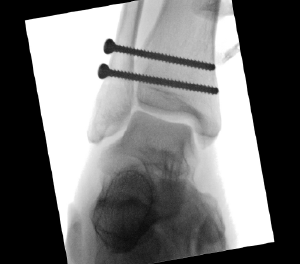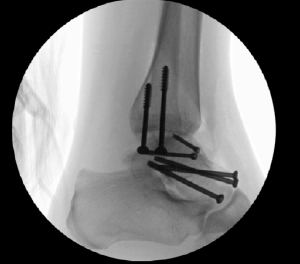Tips for Catching Commonly Missed Ankle Injuries

Case 2, Figure 2: 45-year-old male

Case 3, Figure 2: 13-year-old female
Case 1
The emergency physician noted the patient fell and injured her ankle. The ankle was swollen and tender laterally, but there was no emergency department assessment of her anterior ankle. Diagnosis: severe lateral ankle sprain. She was given a walking boot and crutches, with follow-up in a week.
A few extra details: In fact, she jumped from a wall about six to seven feet high, landed on her feet, then fell over. Unable to walk, she presented to the emergency department the same evening. No anterior joint/talar pain was documented in the emergency department note on the initial visit. However, she was noted to be quite tender there when she returned the next day (after she was called back to the emergency department for an X-ray discrepancy). The original emergency department X-rays (cropped) are in Case 1, Figure 3.
Case 1, Figure 4 includes arrows to show some of the fracture lines visible throughout the talus.
The X-ray study was read as “no fracture” by the emergency physician. The radiologist identified the fractured talus. The patient returned to the emergency department the next day, and a CT scan in Case 1, Figure 5 showed the shattered talus.
The patient was admitted for surgical management, as shown in Case 1, Figure 2.
Case 1 highlights the importance of the history (eg, mechanism, force, and events after) and physical examination (eg, examining the anterior aspect of the ankle). Once the patient’s story is understood, the physician will then look at the X-rays with more focus and should also search for known associated injuries (eg, calcaneus, other foot, knees, hips, and the thoracolumbar spine).

Case 1, Figure 3

Case 1, Figure 4

Case 1, Figure 5
Case 2
The emergency department report showed the patient had mild tenderness laterally and no tenderness over the medial malleolus. He was diagnosed with a STI of the ankle, placed in an air-stirrup, given crutches, and provided with follow-up in the clinic in a week.
He came back on day 10. He was quite specific about the mechanism. He caught the instep of his right foot, and as his left foot went forward, his injured right foot clearly turned out. The mechanism was external rotation, a red flag mechanism. He was unable to bear weight up. At the patient’s follow-up exam, the emergency physician stated, “The patient had very mild tenderness laterally, and he was non-tender over the medial malleolus.” However, as images Case 2, Figure 3A–C show, he also had pain at three other points (points the OAR do not ask us to examine).
Topics: AnkleClinicalEmergency DepartmentEmergency MedicineEmergency PhysiciansfractureImaging and UltrasoundOrthopedicsOutcomePearlsPractice ManagementRadiologyTrauma & InjuryTreatmentX-Ray
Related
-
How to Diagnose Eating Disorders in the Emergency Department
March 11, 2025 - 0 Comment -
Anticoagulant Selection Is Cornerstone of Pulmonary Embolism Treatment
March 11, 2025 - 1 Comment -
Can This Patient Leave Against Medical Advice?
March 10, 2025 - 0 Comment






2 Responses to “Tips for Catching Commonly Missed Ankle Injuries”
March 3, 2018
abwExcellent article. Thank you.
July 30, 2018
Arun SayalThanks abw!
Happy to share these earls from our orthopedic surgeons – and from our patients.
Thanks to both groups for teaching me!
Arun